e*thirteen Grappler Tire
Diameters Offered: 27.5’’ and 2.9’’
Stated Width: 2.5’’
Blister’s Measured Width: 2.42’’ (on 30 mm internal width rim)
Blister’s Measured Weight:
- Grappler 29’’ x 2.5’’, Enduro casing, MoPo rubber: 1,200 g
- Grappler 29’’ x 2.5’’, Enduro casing, Endurance rubber: 1,322 g
MSRP: $60–70 (varies by construction)
Reviewer: 6’, 170 lbs / 183 cm, 77.1 kg
Test Locations: Washington
Test Duration: 5 months
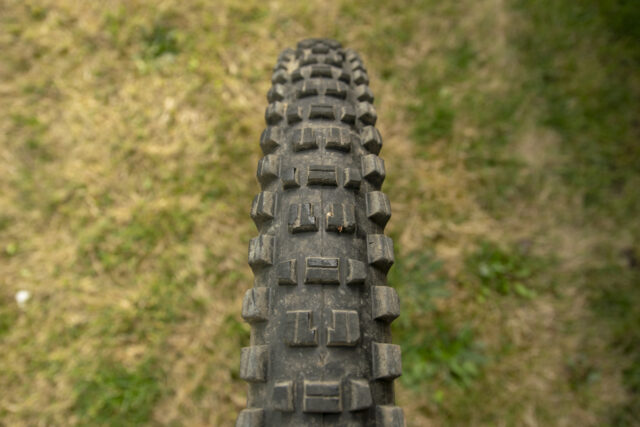
Intro
e*thirteen launched the Grappler tire earlier this year, along with revised casing construction options. We’ve been testing the Grappler on a number of different bikes in a wide range of conditions, and it’s an interesting option that offers a slightly different balance of performance attributes and ride feel than you might expect just from looking at the tread pattern.
Design
We’ll cut to the chase: the Grappler looks a whole lot like the Maxxis Assegai. So we might as well do a deep dive on how their designs compare:
Both use alternating rows of center knobs, with a pair of elongated rectangular(ish) knobs featuring a longitudinal sipe down the center (we’ll call that row A), followed by a three-wide row consisting of a larger center knob with a lateral sipe, flanked by a pair of smaller transition knobs (row B). And both use blocky side knobs, offset to fall between the rows of center knobs.
But there are some differences. For one thing, the Assegai actually uses two alternating versions of the paired center knobs — one row has the knobs pretty much parallel (so let’s call that row A1), and the next has them angled to form a V (row A2) and repeat. That V-shaped cup is oriented with the open end pointing forward when the tread is on the ground, to open the inside edges to help with braking bite. The Grappler’s knobs stick to a simpler A–B pattern, and the A knobs have an extra block on the inside that acts as a cup in the opposite direction to the Assegai A2 knobs, i.e., under pedaling power. The Grappler’s center knobs are substantially shorter than the Assegai’s, at about 4.2 mm (vs. ~5 mm).
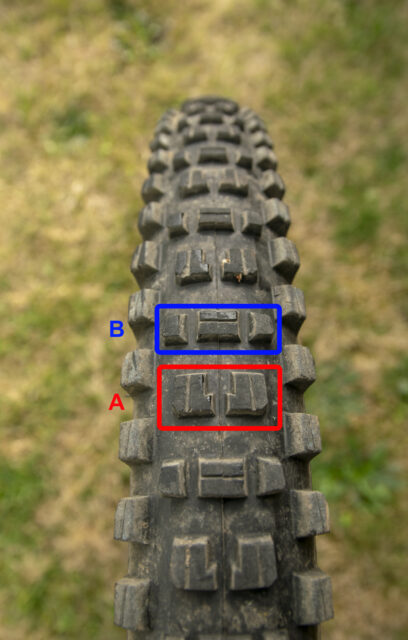
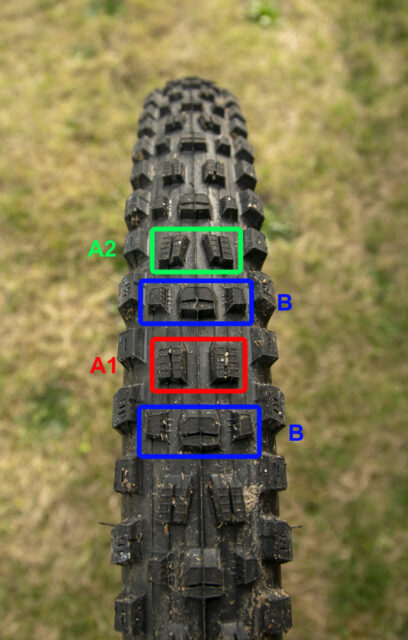
Both tires use blocky side knobs in an alternating pattern, though the Assegai’s vary more dramatically in design than the Grappler’s. The Grappler’s knobs are slightly staggered (so that they’re not directly in line with each other) and the outer side knobs feature a slight chamfer on the outer corner of the leading edge; the buttressing also differs slightly on the inner and outer side knobs, but both feature the same shallow diagonal sipe. The Assegai’s outer knobs use a bit more complex shape, and three small more lateral sipes (which don’t extend across the full width of the knob) but overall they’re visually quite similar.
e*thirteen offers the Grappler in two casing constructions, labeled simply “Enduro” and “Downhill,” both of which are offered in two different rubber compound configurations, “Endurance” and “MoPo.” The Enduro casing uses a dual-ply construction with two 120 TPI layers; the DH version sticks with two plies but bumps them up to heavier 72 TPI fabric and uses a larger rubber insert at the bead. In addition to the new tread design, e*thirteen has revised their casings and construction, and the new Enduro casing is both much more supple than the older LG1 EN design that it replaces, and didn’t give me any of the installation headaches that I’ve run into with some e*thirteen tires of old.
Both rubber configurations use two separate rubber compounds, with the harder-wearing, faster-rolling Endurance version built with a 56a durometer base rubber and a 50a cap on the side knobs; the stickier MoPo uses a 50a base with softer 42a rubber over all of the knobs — both on the center and sides.
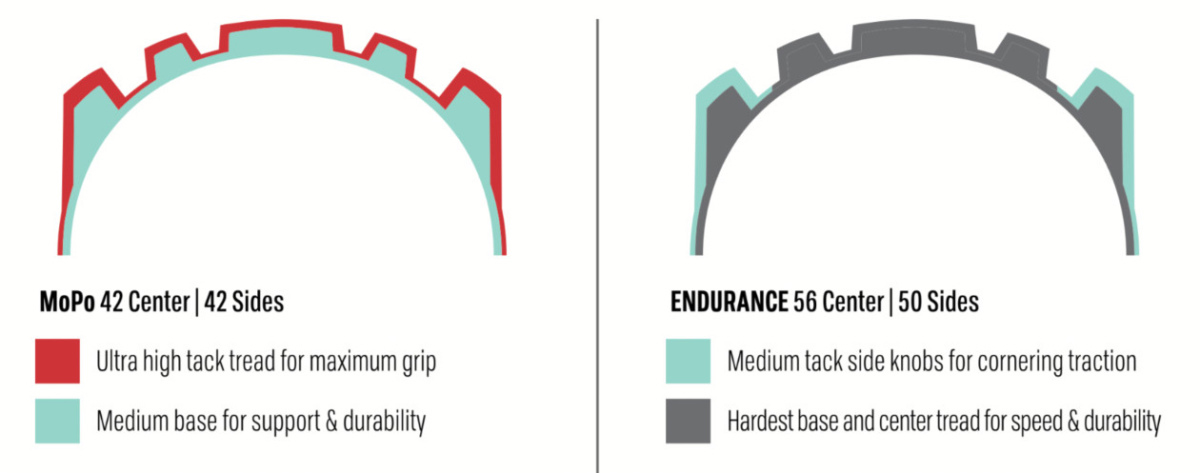
On the Trail
I’ve been spending time on the Grappler in the Enduro casing, with both the Endurance and MoPo rubber, and the tradeoffs between the two compounds are generally in line with what you’d expect — the Endurance version rolls faster and is harder wearing, but less grippy (particularly on harder surfaces); the MoPo is tackier but rolls slower and isn’t as durable. Throughout this section, I’ll simply refer to the Grappler without specifying rubber compound when I’m talking about attributes that generally apply to both versions, and specify rubber compound where there’s reason to differentiate.
For a relatively aggressive tire, the Grappler actually rolls notably well. Is it a fast-rolling tire in the grand scheme of things? Not really. It’s still a burly, aggressive design overall. But the Grappler is significantly quicker than the Maxxis Assegai or DHR II, for example (when comparing like-to-like in terms of rubber compounds), while still offering good cornering and braking grip, particularly when conditions aren’t especially wet, or very loose and soft.
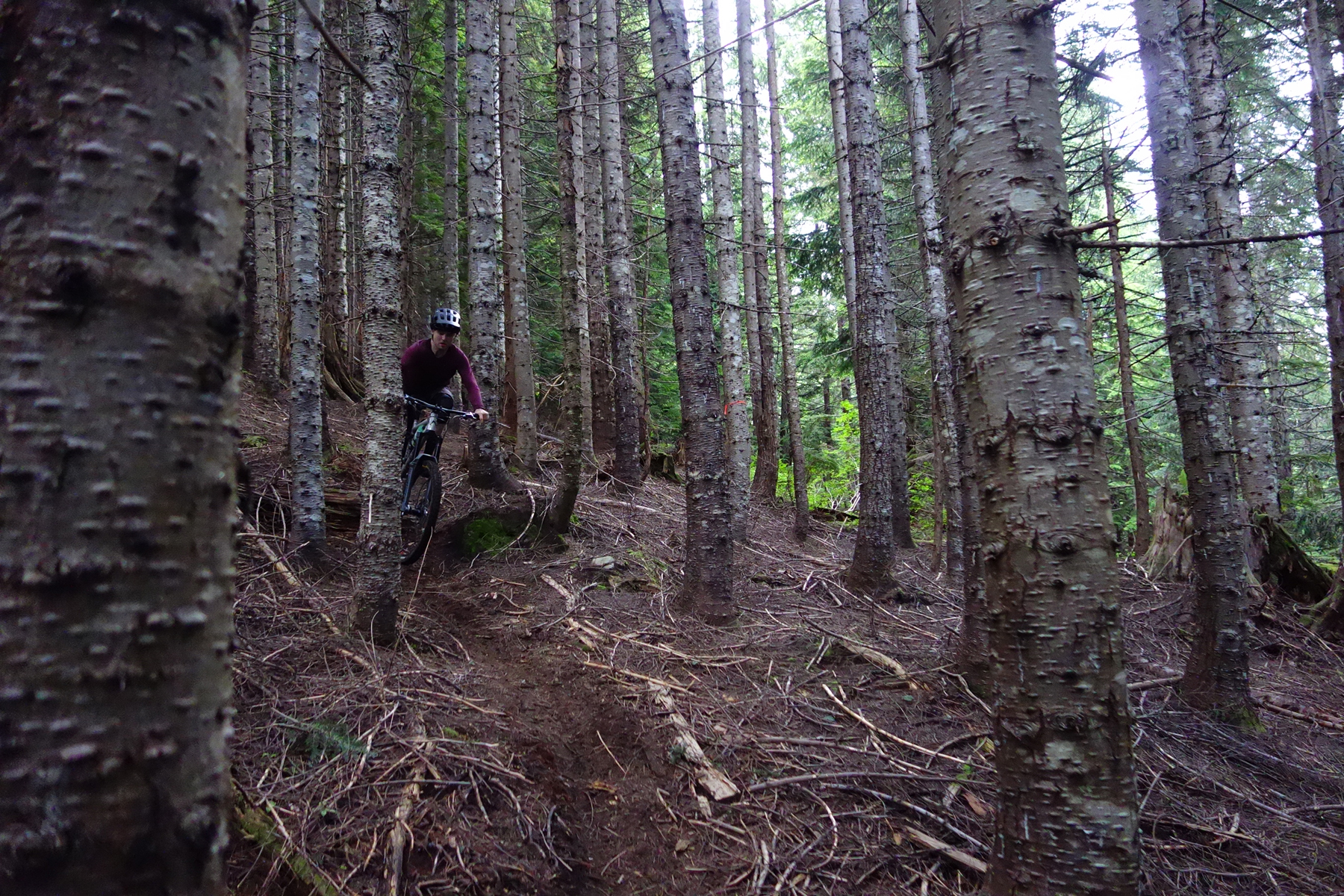
I think the Grappler’s somewhat shorter knob height is a big piece of the puzzle there — the Grappler has a generally quite-aggressive tread pattern, but by pairing that with just slightly shorter knobs than many similarly burly tires, the result is quite good grip in conditions where you don’t need big, tall knobs to sink into soft / loose soil, and there’s less of a rolling resistance penalty as a result. The tradeoff there is that overall performance when things are very soft is more lackluster. In particular, the Grappler brakes very well and predictably on harder to moderately loose surfaces, but loses some traction compared to (especially) the Maxxis Assegai or Minion DHR II when things get really soft and loose.
The Grappler corners consistently and predictably in a lot of conditions. Its side knobs are substantially taller than the center knobs, but the casing is nicely rounded off to prevent that from producing a super square profile. It strikes a good balance between having enough of an open channel between the transition and side knobs to really get the side knobs to dig in when the tire is up on edge while mitigating a lot of the dead space that you need to commit to leaning through on tires like a Maxxis Minion DHF. The transition to the side knobs isn’t quite as seamless on the Grappler as it is on the Assegai, but it’s close.
The rubber formulation also factors heavily into the Grappler’s performance. The Endurance compound feels relatively conventional for a firmer, harder-wearing rubber option. It’s definitely not all that soft or sticky, but rolls well and has mostly proven to be long-wearing, at the expense of some grip on harder surfaces (think roots and rocks) in particular. It’s definitely firmer than Maxxis’ 3C MaxxTerra formulation or Schwalbe’s Addix Soft; based on just a thumbnail squeeze it feels firmer than even Schwalbe’s Addix SpeedGrip and similar to Continental’s new Endurance rubber (more on those coming soon), but I haven’t ridden either of those in a particularly comparable tread pattern. The real point is that the Endurance rubber is, in fact, quite firm and hard-wearing, but the Grappler tread design does a pretty good job of working in such a rubber compound (in contrast to a lot of taller, spikier designs that can feel ping-y and unpredictable in harder formulations, while working quite well in softer ones).
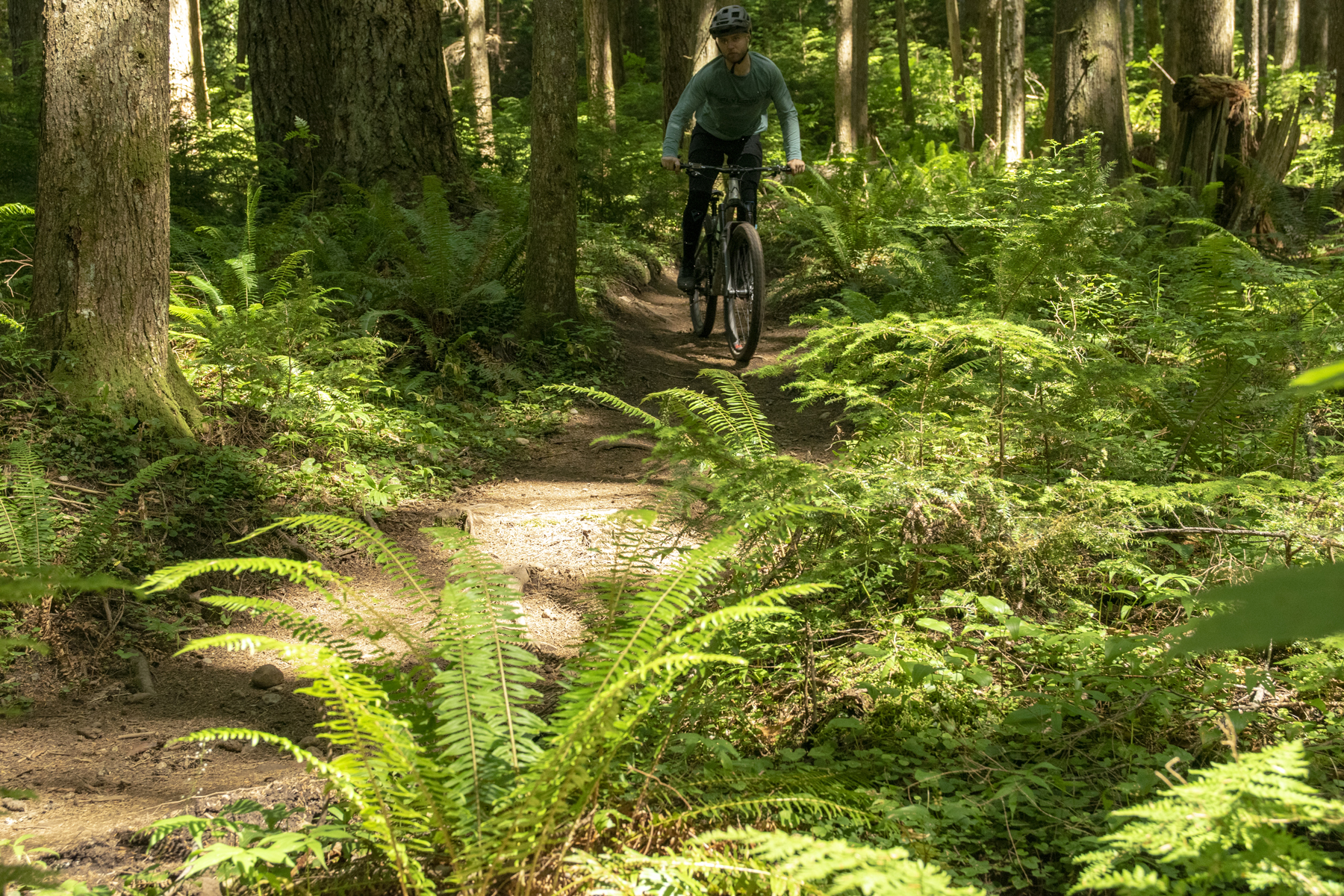
The MoPo rubber is a bit more unusual. The top layer does indeed feel quite soft and tacky — as you’d expect given the 42a durometer that e*thirteen states for it — but the knobs feel notably firm and stiff overall, particularly for what’s meant to be the soft and sticky rubber compound. My hunch is that this is down to a combination of the harder base rubber comprising an unusually high percentage of the total volume of the knob (i.e., there’s a lot of that 50a rubber under a thin 42a cap) and the fairly shallow, modest sipes on most of the knobs offering relatively little give.
That firmness pays dividends in terms of support on harder surfaces. I tend to find the Maxxis Assegai to be a bit squirmy on really hard surfaces (especially when used as a rear tire) and even the MoPo Grappler fares a lot better there. The somewhat lower-volume casing probably helps as well, but I think the rubber plays a bigger role and especially on loose over hard dirt, the combination of a burly tread pattern that can find some purchase on the looser bits, plus knobs that don’t fold and squirm much once you find the bottom, works quite well.
The downside is that, even in the MoPo rubber, the Grappler doesn’t inspire a ton of confidence on wet roots and the like, when you need lateral grip out of the center knobs. Big blocky knobs with lots of edges are great when you’re on a surface that the tire can sink into to get some purchase, but on polished roots with little texture to grab hold of, the Grappler’s firm knobs feel pretty skittish, in the way that harder rubber compound tires tend to. On hard, smooth, slippery surfaces, having the knobs deform more and squish around into a configuration where they find a little bit of grip goes a long way — the difference between, say, a MaxxTerra and a MaxxGrip Assegai is striking — and even the MoPo Grappler doesn’t fare especially well there.
On rock slabs and other harder, but grippier surfaces, the stickier MoPo rubber works pretty well, and is substantially grippier than the Endurance version. It still doesn’t feel mega soft (arguably for the better on rock slabs and the like, since the knobs aren’t as squirmy as softer ones can be) but the tackier outer layer is enough to get the job done.
But again, it all comes down to tradeoffs, and especially if you’ve tended to feel like really sticky, soft rubber tires feel squirmy on harder surfaces, the Grappler just might be the ticket. And particularly since plenty of folks live in places where they don’t have to contend with wet roots and the like, it’s not hard to imagine the Grappler working well for certain riders. The combination of good braking performance with better-than-average rolling resistance for that level of braking bite is especially appealing in the right conditions, and it doesn’t hurt that the Grappler is a lot more affordable than many of the big-name tires, too.
The new Enduro casing is a big improvement over the older LG1 EN in a lot of respects. That older construction was notably burly for its weight but felt quite wooden and lacking in suppleness, and could be very, very hard to mount on tighter-fitting rims. The Enduro casing that e*thirteen rolled out with the Grappler is a bit heavier than the old LG1 EN, but rides way better, didn’t give me any trouble with mounting or sealing tires, and has proven to be quite stout. It feels similar to Schwalbe’s SuperGravity construction in terms of weight and ride quality, and a touch burlier but not quite as supple as Maxxis’ DoubleDown.

I’ve also found the Grappler to wear fairly well. The rear braking edges of the center knobs and the inside edge of the corner knobs are definitely rounding off quite a bit (especially on the MoPo rubber), but the knobs aren’t tearing off or undercutting significantly, and the amount of wear seems entirely reasonable for the mileage that they’ve put down.
Overall, the Grappler feels best suited for use in drier to mixed conditions, for folks who want an aggressive, grippy tire but find a lot of the top options to roll too slowly and/or feel squirmy and vague on harder surfaces. The Grappler’s performance falls off a bit when things get really loose and soft, and even the stickier MoPo rubber isn’t the most confidence-inspiring on slippery wet roots. But for a harder-wearing, decently fast-rolling tire that’s pretty grippy elsewhere, it’s a solid option — especially for the price.
Bottom Line
The e*thirteen Grappler is a good option for folks looking for a burly, aggressive tire that rolls just a bit better than many similarly-aggressive options, especially on hardpack. The Grappler’s braking bite does fall off in very loose, soft dirt and its lateral grip on wet roots isn’t very good, but the Grappler is consistent and predictable in dry to mixed conditions and — especially given its modest price — is a good option for riders who are happy with those tradeoffs.

I had the prior version. It was impossible to insert any insert. Hard enough to get the tire on the rim. Good to know it wasn’t my inability.
Did you get a chance to ride the tire in dry – loose over hard conditions ? If so, do you have input on how it compared to Assegai Maxgrip front/DHR II Maxterra rear in those conditions. Also, any idea or guess on how a Grappler MOPO front would pair up with an DHR II Maxtera rear – wondering if a new e Maxterra DHR II provides more cornering grip and would lead to a bike understeer.
Thanks, V